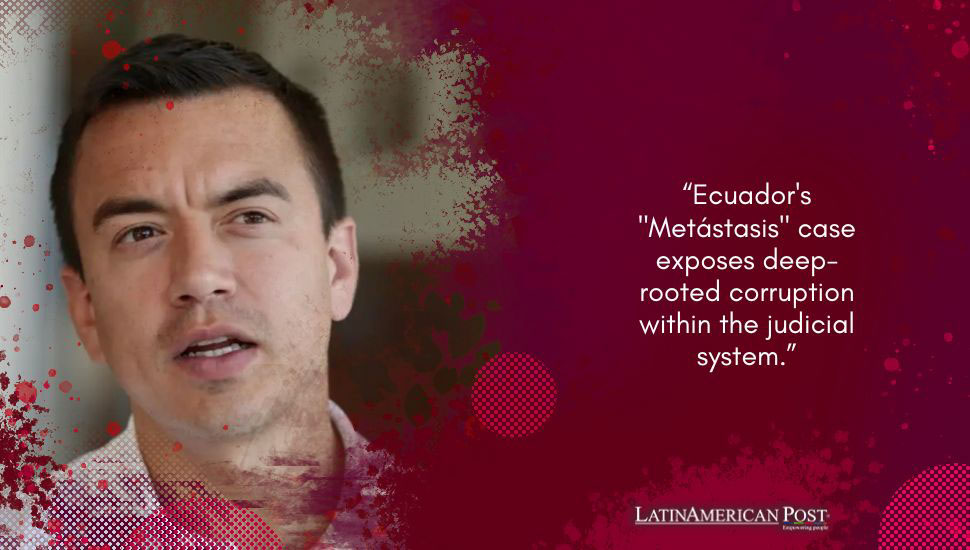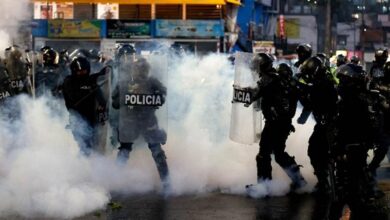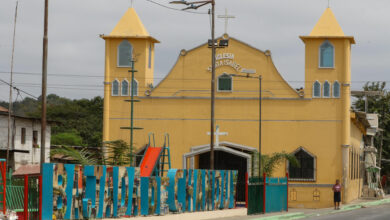Ecuador’s Judicial Corruption: The Irony of Justice Turned Criminal

Ecuador’s “Metástasis” case exposes deep-rooted corruption within the judicial system, where those sworn to uphold the law have allegedly aided organized crime. As the scandal unfolds, it reflects a broader issue of judicial corruption across Latin America.
The Metástasis Scandal
The “Metástasis” case, which erupted in Ecuador in late 2023, is a powerful example of the devastating effects of corruption within a country’s judicial system. At the heart of the scandal is the alleged infiltration of organized crime into Ecuador’s legal, police, and prison systems, exposing the fragility of the country’s institutions.
The Ecuadorian Attorney General’s office has presented an accusatory indictment against 37 individuals, including former high-ranking officials such as Wilman Terán, ex-president of the Council of the Judiciary, and Ronny Aleaga, a former congressman. The case also implicates judges, lawyers, and police officers who are suspected of collaborating with organized crime groups, particularly the late drug trafficker Leandro “El Patrón” Norero. Norero, who was killed in prison in 2022, allegedly used his influence to secure favorable judicial outcomes, protect himself from prosecution, and manipulate the system to benefit his criminal network.
The revelations of this extensive corruption network—comprising judges, police, and other officials—have sent shockwaves through Ecuador. The investigation revealed that Norero’s criminal empire extended its reach into the very institutions meant to combat crime, showcasing how the judiciary, intended as a safeguard of justice, can be weaponized to shield organized crime.
This scandal highlights the paradox of judicial corruption, where those responsible for enforcing the law become accomplices to criminal enterprises. The irony is unmistakable: Justice is supposed to uphold morality and order, yet it has been twisted into a tool for crime and corruption in Ecuador.
A Latin American Plague
Judicial corruption, though shocking, is not unique to Ecuador. Across Latin America, corruption in the judiciary has been a persistent problem, undermining the rule of law and allowing crime to thrive. Stories of judges, prosecutors, and law enforcement officials being bribed or coerced into aiding criminal activities are common from Mexico to Brazil.
In Mexico, corruption within the judiciary has been an enduring issue. Drug cartels have historically infiltrated law enforcement and judicial systems, ensuring that key members of their organizations avoid prosecution or receive reduced sentences. In some cases, entire law enforcement units have been bought off to protect criminal enterprises, allowing organized crime to operate with impunity. Rather than acting as a check on these activities, the judiciary has often been co-opted by powerful cartels.
Similarly, in Brazil, the sprawling “Operation Car Wash” scandal exposed the extent to which corruption had permeated the country’s political and judicial institutions. Though the operation initially focused on uncovering corruption in the state-owned oil company Petrobras, it eventually revealed a massive web of bribery involving top political and judicial figures. The scandal eroded public confidence in the judiciary and sparked widespread protests demanding accountability and transparency.
Guatemala has also faced its share of judicial corruption, with efforts to combat organized crime and political corruption thwarted by corrupt judges and prosecutors. The International Commission Against Impunity in Guatemala (CICIG) was established to help the country tackle these issues, but even with international support, the judiciary remains vulnerable to criminal influence.
These examples highlight the broader issue of judicial corruption across Latin America. Criminal organizations, from drug cartels to political mafias, recognize the judiciary as a critical battleground. By corrupting judges, prosecutors, and law enforcement, they can ensure that justice serves their interests rather than the public good. This perpetuates crime and undermines trust in democratic institutions and the rule of law.
The Paradox When Justice Serves Criminals
The Metástasis case in Ecuador underscores the tragic irony of judicial corruption. The institutions tasked with upholding justice have been compromised, turning the judicial system into an extension of criminal networks. This paradox of power, where the law enforcers become protectors of criminals, represents one of the most insidious forms of corruption.
Judicial corruption is hazardous because it erodes public trust in the system. Citizens look to the judiciary for fairness and accountability, but when these institutions are tainted by corruption, people lose faith in their ability to seek justice. This erosion of trust often leads to social instability, as individuals and communities may resort to vigilantism or other forms of extrajudicial action to protect themselves from crime.
In Ecuador, the revelations about judges and police officers working for Norero’s criminal organization are particularly damaging. The involvement of high-profile figures like Wilman Terán, the former president of the Council of the Judiciary, highlights how deep the rot goes. With organized crime infiltrating the judiciary, ordinary citizens seeking protection from the law have little recourse.
This paradox extends beyond Ecuador. In Mexico, for example, drug cartels have effectively co-opted parts of the judicial system to ensure their operations remain unchallenged. Judges who should be prosecuting cartel leaders are instead on their payroll, issuing rulings that allow criminals to walk free or avoid significant penalties. This dynamic creates a vicious cycle: criminal organizations grow more potent as the judiciary becomes more corrupt, further undermining the rule of law.
The irony of judicial corruption is that it turns the very concept of justice on its head. Rather than being a bulwark against crime, the judicial system becomes a tool of oppression used by criminals to further their interests. This corruption, arguably the worst kind, leaves societies vulnerable to lawlessness and instability.
Can Latin America Overcome the Judicial Corruption Crisis?
While judicial corruption is a widespread problem in Latin America, it is not insurmountable. Some countries have taken significant steps to reform their judicial systems and combat the influence of organized crime. Can these efforts be replicated across the region, or is judicial corruption too deeply entrenched?
One success story comes from Colombia, which has made considerable progress in fighting judicial corruption. In the wake of its drug wars in the 1980s and 1990s, Colombia invested heavily in reforming its judicial system, improving transparency, and strengthening institutions. While corruption has not been eradicated, Colombia’s efforts have led to more robust checks and balances within the judiciary. These reforms, combined with international cooperation and support, have helped the country make significant strides in reducing the influence of organized crime on its legal system.
Another example is Chile, which has historically enjoyed a relatively clean judiciary compared to its neighbors. Chile’s emphasis on transparency and accountability within its judicial system has made it a model for other Latin American countries. The country’s anti-corruption institutions are well-regarded, and the judiciary is stringently checked to prevent undue influence from criminal organizations or political interests.
However, many other countries in the region are struggling to replicate these successes. In countries like Honduras and El Salvador, where gangs wield significant power, judicial corruption remains rampant. Efforts to reform the judiciary are often met with resistance from entrenched interests, making it difficult to effect meaningful change.
For Ecuador, the Metástasis case offers a crucial opportunity. The scandal, while devastating, has shone a spotlight on the need for judicial reform. By addressing the root causes of corruption and implementing transparency measures, Ecuador has the potential to strengthen its institutions and restore public faith in the judicial system. International cooperation, such as supporting anti-corruption organizations, will also be critical in implementing reforms effectively.
Ultimately, overcoming judicial corruption in Latin America requires a concerted effort from governments, civil society, and international partners. By improving transparency, strengthening institutions, and holding corrupt officials accountable, the region can restore trust in its judicial systems and ensure that justice serves the people, not criminals.
The Metástasis case in Ecuador is a stark reminder of the dangers of judicial corruption. When the guardians of justice are compromised, the very foundations of democracy and the rule of law are at risk. Across Latin America, similar cases demonstrate how organized crime exploits weak judicial institutions to maintain power and evade accountability.
Also read: Ecuador’s Hidden Homicide Crisis: The Impact of Manipulated Crime Data
However, as countries like Colombia and Chile have shown, judicial corruption is not inevitable. With the right reforms, transparency, and international cooperation, Latin America can confront this crisis and restore trust in its institutions. The road ahead is challenging, but the fight for a just and equitable legal system must be won.





